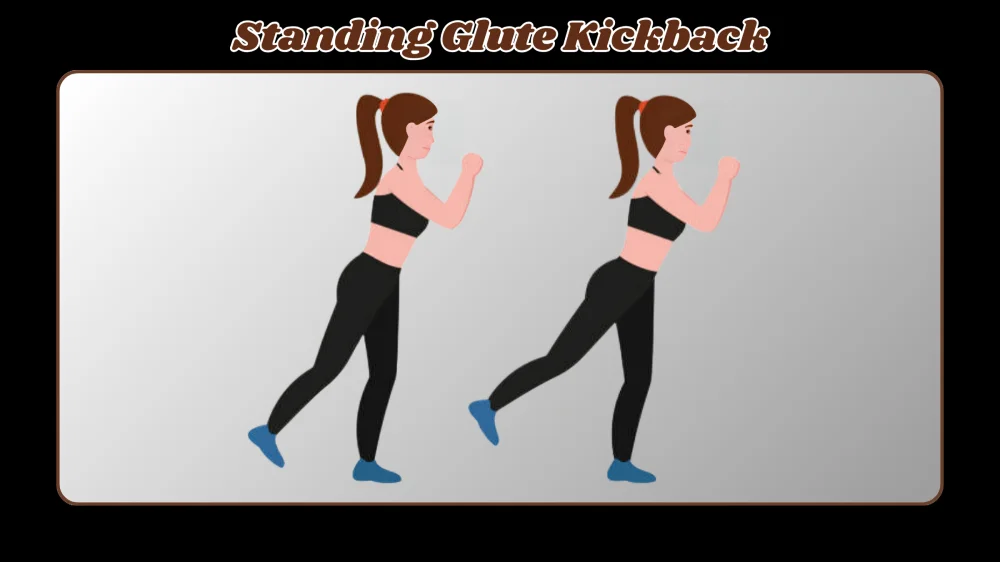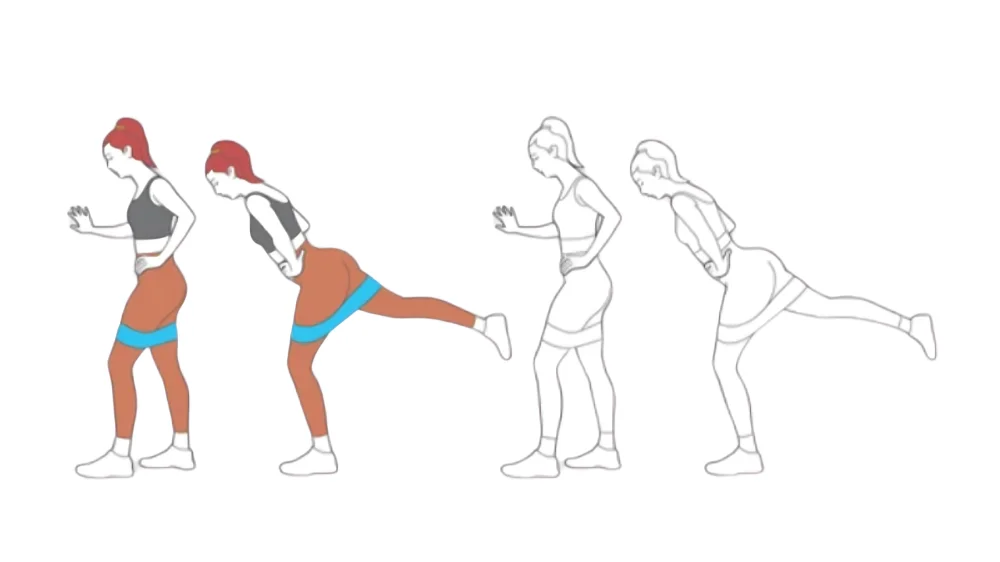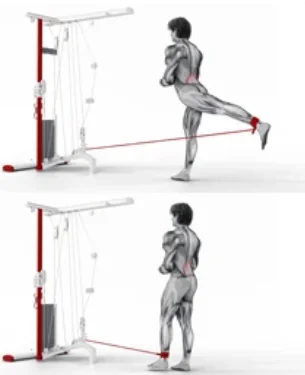EXERCISE
What is a Standing Glute Kickback: A Complete Guide

Are you looking to sculpt and tone your lower body while also improving balance and stability? Look no further than the standing glute kickback! This multi-joint exercise targets the glutes, hamstrings, and core muscles while torching the entire body. Get ready to lift, tighten, and firm that booty with this challenging yet rewarding move.
Table of Contents
What is a Standing Glute Kickback?
The Standing Glute Kickback is a pretty straight and simple fitness exercise. Stand straight and then kick one of the legs with a 90-degree bend from the knee joint. The prime target muscles in this exercise are the gluteal muscles, with emphasis laid on the gluteus maximus, being the larger muscle compared to all the gluteal muscles.


That would mean that this exercise not only works your glutes but also works with your hamstring and other core muscles to help keep your body in place as you move. Making the Standing Glute Kickback a great option for those looking to strengthen and firm the backside of the body while increasing both balance and stability in the process.
To get the most out of the exercise, keep the form: You have to straighten the back, keep the shoulders down and relaxed, and have the core muscles tight. Heels should be back and toes pointing right up toward the ceiling, and contract those glutes. Make sure that you give it a powerful kickback; you’ve got to give it all you have. Meaning, whether in a gym setup or at home during exercise, Standing Glute Kickbacks may just do great wonders to reach those desired gains in the posterior department.
What Muscles Are Targeted during a Standing Glute Kickback?
The standing glute kickback doesn’t only benefit the glutes but activates several other muscle groups in your lower body, making it an excellent all-encompassing exercise for sculpting and strengthening. When you perform this exercise facing a band or cable machine, holding the handle or strap with one hand, and maintaining a neutral pelvis alignment, you’re setting the stage for a comprehensive lower body workout. This movement powerfully engages the gluteus maximus, aiding in lifting or shaping the rear end.
Further, the exercise targets your hamstring muscles, which are critical in extending your hip on each movement of kickbacks. More so, well-developed hamstrings improve athletic ability, knee strength, and general strength of the leg. In addition, right from the start, the stabilizing muscles like the quadriceps and core of the body have an important role in maintaining balance. These muscles are focused on your glutes and hamstrings to ensure movement control and a minimized risk for injury, so you can exhibit peak explosiveness.
Benefits of Standing Glute Kickback Exercise
- Enhances lower body strength and fitness by engaging glutes, hamstrings, and core muscles.
- Enhances athletic performance by increasing power and explosiveness in movements like running, jumping, or squatting.
- Prevents injuries related to weak glutes or lower body imbalances.
- Contributes to better posture and reduces strain on the lower back.
- Leads to improved muscle tone and definition in the buttocks, promoting functional strength.
Proper form and technique for a safe and effective kickback


- Stand tall with feet hip-width apart, engaging core for stability.
- Keep a slight bend in the supporting leg to prevent knee locking.
- Shift weight onto one leg while extending the other straight back.
- Squeeze glutes at the top of the movement before slowly lowering back down.
- Maintain control throughout the exercise, avoiding swinging or momentum.
- Focus on connecting the mind to muscle and visualize contracting glutes with each repetition.
- Consistently breathe throughout the movement, practicing mindfulness and intentionality.
Variations and modifications for different fitness levels
Regarding the standing glute kickback, there are numerous ways to tailor and adjust the exercise to suit your fitness level.
For beginners, embarking on bodyweight kickbacks offers an excellent opportunity to build strength and acquaint themselves with the movement.
Intermediate individuals can incorporate resistance bands or ankle weights to increase intensity gradually. This added resistance challenges the muscles further without compromising form.
Advanced practitioners may opt for using a cable machine or even experimenting with single-leg variations for an extra challenge.
How to challenge yourself and progress with this exercise
To enhance your standing glute kickbacks, consider using a varied tempo, extending the tempo with ankle weights or a resistance band to up the challenge, all while keeping the correct stance. You might find it beneficial to either slow down or speed up the movement for a deeper glute engagement. To spice up your routine and address muscle imbalances, incorporating unilateral exercises that focus on one leg at a time could offer a fresh challenge and engage your muscles differently.
Other Exercises to Pair with Standing Glute Kickbacks
Pairing Standing Glute Kickbacks with other targeted exercises can help you achieve a well-rounded workout.
- Combine squats, lunges, and deadlifts for multiple muscle group engagement.
- Incorporate hip thrusts or bridges to activate glutes in a different range of motion.
- Include core-strengthening exercises like planks or Russian twists for stability and support.
- Mixing exercises prevents plateaus and promotes continuous strength and muscle development.
Mistakes to avoid
- Avoid arching your back excessively to avoid straining the lower back.
- Avoid improper foot positioning or not fully extending your leg during the kickback.
- Avoid swinging your leg or leaning too far forward during the movement.
Precautions and Safety Measures for Performing a Standing Glute Kickback
- Warm up your body before starting the exercise routine to prevent injuries.
- Maintain proper form during the exercise to avoid straining the lower back.
- Start with lighter weights or resistance bands for beginners and gradually increase intensity.
- Listen to your body and stop if you feel sharp pain or discomfort.
- Breathe properly during each repetition to oxygenate muscles and support engagement.
Conclusion
The standing glute kickback is pretty basic, yet very effective at firming and toning your glutes. By heeding these suggestions and incorporating this exercise into your fitness routine, you’ll be able to boast a stronger, sculpted butt in no time. Always remember to listen to your body and adjust the intensity according to your needs.
-



 GENERAL3 weeks ago
GENERAL3 weeks agoUncovering the World of кинокрадко: The Dark Side of Film Piracy
-



 GENERAL2 weeks ago
GENERAL2 weeks agoUnveiling the Art of преводсч: How Translators Bridge Language Barriers
-



 GENERAL3 weeks ago
GENERAL3 weeks agoThe Journey of iamnobody89757: From Anonymous User to Internet Sensation
-



 YOGA4 months ago
YOGA4 months ago4 Person Yoga Poses for Beginners




















